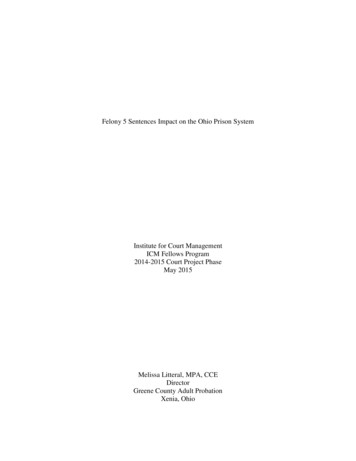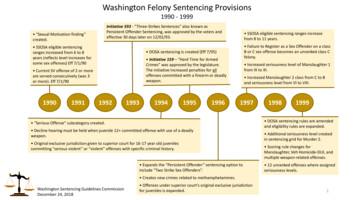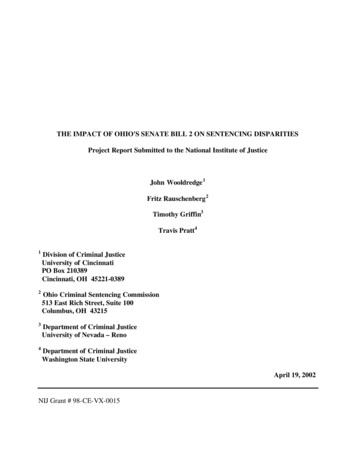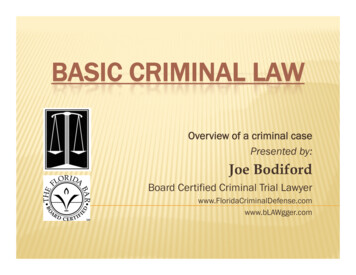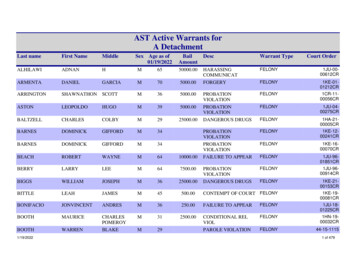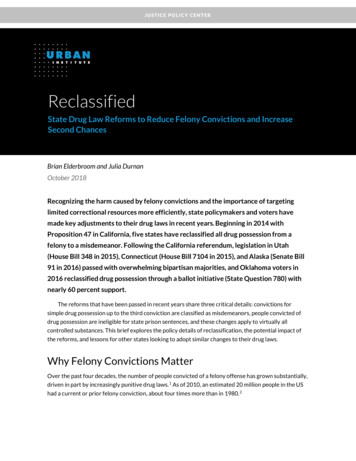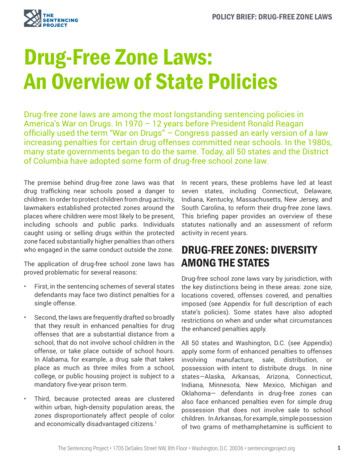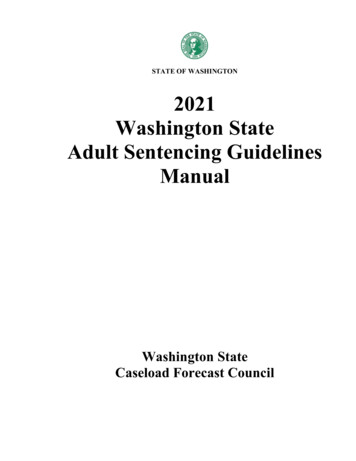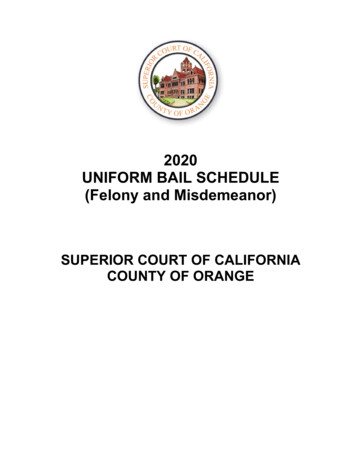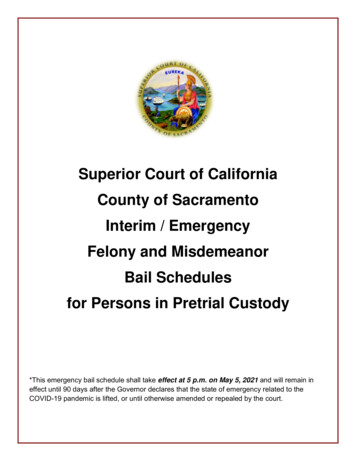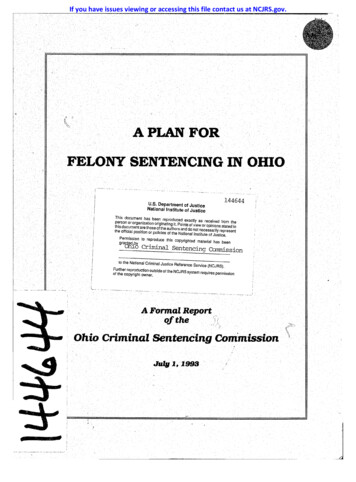
Transcription
If you have issues viewing or accessing this file contact us at NCJRS.gov.A PLAN FORFELONY SENTENCING IN OHIOU.S. Department of JusticeNational Institute of JUstice144644This document, has been reproduced exactly as received fro s;n or organization originating it. Points of view or opinions sta e ocument are those of the authors and do not'Ithe official position or pOlicies of the Nationallns :s;f [; :esent:r mi n3 l3to reproduce this copyrighted material has beenCriminal Sentencing Commissionto the National Criminal Justice Reference Service (NCJRS). rt e :r tside of the NCJRS system reqUires permissionA Formal Reportof theOhio Criminal Sentencing CommissionJuly 1,1993er
OHIO CRIMINAL SENTENCING COMMISSIONChief Justice Thomas J. Moyer, Supreme Court of Ohio, ChairSenator Betty Montgomery (Wood County), vice ChairSheriff Loran Alexander (Wayne County)Victims' Representative Sharon Boyer (Columbus)Police Chief Sherwood S. Eldredge (Lyndhurst)Representative Tim Greenwood (Lucas County)Common Pleas Judge Burt W. Griffin (Cuyahoga County)Senator Jeffrey D. Johnson (Cuyahoga County)State Public Defender James KuraCommon Pleas Judge JUdith Ann Lanzinger (Lucas County)Municipal Judge Alice o. McCollum (Dayton)Appellate Judge John T. Patton (Cuyahoga County)State Highway Patrol Superintendent Col. Thomas W. RiceDefense Attorney Jon Richardson (Toledo)Representative Ronald J. Suster (Cuyahoga County)Prosecuting Attorney Gregory A. White (Lorain County)Common Pleas Judge Gale E. Williamson (Wood County)OHIO STATE BAR ASSOCIATION D LEGATECapital Law School Professor Max KravitzSUPREME COURT LIAISONRichard Dove, Associate Director, Supreme Court of OhioCRIMINAL SENTENCING ADVISORY COMMITTEESTATUTORY MEMBERSDirector of Rehabilitation and Correction Reginald WilkinsonParole Board Chairwoman Margarette GheeCorrectional Institution Inspection Cmte Director Peter DavisOTHER MEMBERSCounty Commissioners' Association Designee Kimberly CrawfordChief probation Officers' Association Designee George FarmerOhio State Univ. Public policy & Management Professor Ron HuffCase Western Reserve University Law Profes8or Lewis KatzHalfway House Assoc1at1on Representat1ve James LawrenceCommon Pleas Judge Guy L. Reece, II (Franklin County)NAACP Representative Charles See (Cuyahoga County) STAFFDavid Diroll, Executive DirectorFritz Rauschenberg, Research DirectorMary Ann Torian, AttorneyBarbara Herman, ResearcherCynthia Ward, Administrative AssistantI
ACKNOWLEDGEMENTSThe Commission thanks many people for their contributions.OhioProsecuting Attorneys Association Director John Murphy workedthrough hundreds of offenses to help develop a plan to simplify theCriminal Code and make it more proportionate.Department ofRehabilitation and Correction research chief Steve Van Dine helpedthe Commission understand the prison system and the impact of theCommission's work on it. Former State Public Defender Randall Danaworked to foster rehabilitation and fairness. State Highway PatrolCaptain Ken Morckel kept law enforcement's concerns before theCommission.Lt. Kent Shafer and others in the Columbus PoliceDepartment's narcotics unit helped frame the debate on drugsentencing. Deborah Zandarski patiently articulated the concernsof inmates.Justice Fellowship's Richard Erickson fosteredprincipled sentencing and restitution.Former staff researcherWilliam Dauer diligently gathered important data.Lt. GovernorMike Dewine and his counsel,Charlie Price,welcomed theCommission's participation in informal groups that helped shape theAdministration's approach to prison crowding and parole issues.Other key contributors include:Jill Stone of the State PublicDefender's office; Tim Benedict and his colleagues at the PharmacyBoard; victims' advocates Mark Zemba of the Attorney General'soffice, Gayle Smith of the Prosecuting Attorneys Association, Davidvoth, and Julie George; Sandy Ortega and the staff of Oriana House;former Commission members Robert Hickey, Charles Rush, and SandraRogers; former Parole Board chair Ray Capots; DRC administratorsTom Stickrath, Jill Goldhart, and Phil Parker; wardens Arthur Tateand William Dahlman; Lt. Col. Richard Curtis and others at theHighway Patrol; inmate advocates Patricia Richie and MarthaKilbane; interns Shelton Beasley, Susan Anitas, and Mark Nesbit;judges, inmates, law enforcement officers, victims advocates,academicians, defense and prosecuting attorneys, DRC staff, andothers who provided expertise to the Commission; and those whomonitored the Con ission's work for legislators and others.Out-of-state help came from Kay Knapp of the Institute for RationalPublic Policy; Judge John Marzulli, who chaired the New JerseySentencing Pathfinders Committee; Judge Theodore McKee, vice chairof the Pennsylvania Sentencing Commission; Robert Re, SupervisingAttorney in New York City's narcotics courts; Sue Cain, Director ofthe Tennessee Sentencing Commission; and others.The Commission also thanks the Governor's Office of CriminalJustice Services for Federal funding that allowed the Commission toexpand its resear'ch initiatives; Director Gary Mohr, Sharon Berger,Linda Watts, ShaJi:man Sayre, and others at the Office who supportedthe Commission's 'work; and Administrative Director Steven Stover,Jim Cohagan, Jackie Crowley, Susan Foor, Beth Wineland, and othersat the Supreme Court who assisted the Commission.2
CONTENTSMEMBERS AND STAFF .1ACKNOWLEDGEMENTS.2CONTENTS . . 3INTRODUCTION. . . . .What Is The Sentencing Commission?.What Is The Criminal Sentencing Advisory Committee?What Is Next For The Commission? . . .788HOW THE COMMISSION IS FULFILLING ITS DUTIES9o.Public Safety And Punishment . . . . . . . . .Prison Crowding And Resource Management. . . . .Certainty And Judicial Discretion. . . . .0"Deterrence . . . . . . . . .Proportionality, Uniformity, And Fairness. . . . .Rehabilitation And Treatment . . . .Simplification And Understandability . . . . .Studies. . . . .0 .Soliciting Input . . . . . . . . . .THE COMMISSION'S RECOMMENDATIONS.79101113131516161719THE DISCRETION AND DUTIES OF JUDGE . . .Judicial Discretion. . Sentencing Purposes And Principles. .Prohibited Bases . . . . . . . . . . .Factors Regarding Seriousness And Recidivism. .Presumptions To Guide Sentencing. . . .Presumption Against A Prison Term. .Presumption In Favor Of A prison Term.No Presumption . . . . . . . 191919202021212121THE CONTINUUM OF SANCTIONS . . Direct Sentencing And Duration. .Expanded Eligibility. . . . Rewarding Success And Penalizing Violators.Drug Violators Presumption . .Residential Sanctions .Non-Residential Sanctions . .Financial Sanctions . . . . . . . .Expanded Restitution Expanded Fines . . . . Expanded Reimbursements.Improving Collections . . . . .2122223222223232525252626
PRISON SENTENCES . . . . . . . . . . .Ranges Of Prison Terms: Honest Sentencing.Minimtun On First Prison Term. . . . . . Maximum For The Most Serious Offenders . . .Terms Between The Minimum And The Maximum .Mandatory Prison Terms. . . . . . Firearms Terms . . . . . Repeat Violent Offender Term Major Drug Offender Term .Other Additional Terms . Consecutive Prison Terms. . .Post-Release Control. . .0 . . . . . . .Prison Terms Summary. . . . . .Limited Retroactivity. . 2727282828282829292929303030FIVE TIERS OF FELONIES . . . .Neutral Conversions . . . . .Repeat Offender l ncements.Changing The Felony Theft Threshold . . . .Non-Neutral Conversions . .Penalties Increased. . Penal ties Decreased. . . Offenses Redefined . . . .Non-Criminal Code Offenses . . . . . . "Offense Of Violence". . . . Duplicate, Overbroad, And Obsolete Offenses31323333D34343434353536DRUG OFFENSES. . . . . . Simplifying The Drug Laws . Fostering Fairness. . . . .Mandatories And Presumptions In Drug Cases.Drug Sentencing Summary . . .Powder Versus Crack Cocaine . . 40THE SENTENCING HEARING . .The Judge's Duties .4142SENTENCE MODIFICATIONS . . Judicial Release. . . . . . Caps Removal And Extended Sentence Review .Earned Credits. . . .Intense program Prisons ("Boot CampSU) Furloughs . . 424244444545IMPOSING BAD TIME. . Duration. . . . . . . . . . . . . . .Holdover Period . . . . . .Procedural Safeguards 464647RESTRUCTURING PAROLE: POST-RELEASE CONTROL. Parole Board Duties Duration. . . . . . . . . . . . . . . . .4748484363637383846
48Violations.APPELLATE REVIEW OF SENTENCES . . . . . . . . . . Why Appellate Review? . . .Appeals Of Right . . . . . . . . .Appeals By Leave Of Court . . . . . . . . .The Appellate Court's Options Nonappealable Sentences . .Timing And Record . . . . .5050505050VICTIMS' RIGHTS. . . . . . .Broaden Application To All Felonies . .Notice And Opportunity To Be Heard. . . . . .Protecting Victims . . . . . . . . . . .Minimizing Contact . . . . . . . . . .Discouraging Retaliation. Speedy Trials . . . . . . . . . . .Victims' Property . . . .Enforcing Compliance. . . .515151525252525252PRISON POPULATION PROJECTIONS494953Background . . . . . . . . . . . . . . . . .What Happens If We Do Nothing? . .Impact Of The Commission's Recommendations . . . . The Commission's Assumptions. . Prison Intake . . . . .The Pool Of Offenders . . . . . . . .Sentence Ranges . . . . . . . . . Where will Judges Fall In The Ranges?. .Theft Offenses. . . . . . .Presumption For Or Against Prison . . . . . . .Drug Offenses . . . . . " . . . . . . . . . . "Mandatory Gun Sentences . . . . . . . Repeat Violent Offender And Major DrugOffender Enhancements . . . . . . . .Consecutive Sentences . .Jail Time Credit. . . . . . . . . . Judicial Release. . . . . . . . .Extended Sentence Review. Bad Time. . . . . " . . .Post-Release Control.Intense Program PrisonsEarned Credit . . . . .The Upshot . . . . . . . Retroactivity. . . . . . . . . . . . . . . . . . . . . . . .SAVINGS AND COSTS xpected Decrease In State Prison Costs. . . Importance Of Shifting Funds To Local Government .The Biennial Budget Bill . . . . . . . . . . . . . .5606060
Victims. . . . . .Theft Cases . . . .Appellate Review .New Revenue. . . .61626263COSTS OF VARIOUS SANCTIONS . .65Residential Sanctions Generally. . .Non-Residential Sanctions Generally.Cost Of An Offender's Sentence . . . . .State Prisons. . . . .Capaci ty. . . .Cost Savings. . .Marginal Costs.Prison Construction . . . . . . . . . . . . . .Boot Camp Prison.County Jails . .Community-Based Correctional Facilities. . . . .Minimum Security Misdemeanant Ja ls.Debt Service . . . . . . . . . . . . . . .Halfway Houses.Treatment. . .Day Report ing .Electronic Monitoring.Intensive Supervision. . . . .Basic Supervision. . . . . . . . . . .a e e 7070707072NOTES ON DISPARITY . . .The Commission's Plan.The Commission's Research.NOTES ON UNIFORMITY .6565656666666767676768686869697272.75THE COMMISSION'S DRAFTS7777. 103Sentencing For Felonies.Crime Victims' Rights . . .The Report also includes an Appendix, which is printed separately.The Appendix contains:(1) A list of felonies as reclassified bythe Commissioni (2) A list of drug offenses as reclassified by theCommissioni (3) Tables summarizing the Commission's plan for LSD,heroin, and hashish traffickingi(4)Tables comparing theCommission's plan for crack cocaine, powder cocaine, and marijuanasentencing with current lawi (5) Notes on prison populationforecastingi (6) An important tracking study that provides baselinedata on offenders in 18 targeted countiesi and (7) A report thatprofiles non-prison sanctions and offenders in them in the 18counties.6
INTRODUCTIONThis lS the first formal report of the Ohio Criminal SentencingCommission.It contains a felony sentencing structure for adultoffenders.It also contains draft language for legislativeconsiderationand the Commission'sresearch on offenders,sentencing, costs, and the impact of these proposals on prisons andother correctional resources.The Commission has initiated research, heard testimony, and debatednumerous sentencing issues. It has met from one to four full daysmonthly since February, 1991, and has held many additional informalcommittee meetings. The Commission serves without compensation.This plan fosters public safety and victims' rights, yet easesprison crowding.It guards judicial discretion, yet providf1Sgreater certainty and less disparity. It strives for rairness andsimplicity.The plan should not be read selectively. It is a balanced packagethat is supported by the judges, prosecuting and defense attorneys,law enforcement officers, and crime victim on the Commission.There is no minority report.The Commission's recommendations promise immediate relief for theState's beleaguered prison system, without jeopardizing publicsafety. The plan also could reduce growth in the prison populationby 10%, freeing 40 million each year in operating costs alone.The Commission supports generating more revenue by expandingfinancial sanctions and making them more collectible.However, to make this workable, it is important that. State-fundedpunishments are available locally.These sanctions allow forproportionate and fair sentencing that does not overburden Stateprisons or local budgets.What Is The Sentencing Commission?The Ohio Criminal Sentencing Commission is a 17-member body createdin statute to study the State's sentencing laws and correctionalresources, to recommend comprehensive sentencing plans to theGeneral Asserrilily, to monitor any plans enacted, and to advise theGeneral Assembly. The Commission is a permanent body.The Commission is chaired by the Chief Justice of the Ohio SupremeCourt.The Chief Justice appoints five members including oneappellate, one municipal, and three common pleas judges.TheGovernor appoints five members including a prosecuting attorney,defense attorney, sheriff, municipal or township law enforcementofficer, and a crime victim. Four melnbers of the General Assemblyare on the Commission, one from each caucus.Ex officio members7
include the state Public Defender and the Superintendent of theHighway Patrol.What Is The Criminal Sentencing Advisory Committee?The Criminal Sentencing Advisory Committee, also created bystatute, assists the Commission.By law, it consists of theDirector of Rehabilitation and Correction, the Chair of the ParoleBoard,and the Director of the Legislature's CorrectionalInstitutions Inspection Committee. The Commission invited(othersto participate,includingrepresentativesfrom theCountyCommissioners Association, the Halfway House Association, the ChiefProbation Officers Association, the NAACP, and academia.TheAdvisory Committee meets with the Commission and par'ticipatesfreely.IIWhat Is Next For the Commission?The Commission will work with the General Assembly on reftning theenclosed felony plan. If the plan is adopted, the Commifssion willwork to train practitioners, develop more cost-effecti e and safesentencing options, monitor the plan and its costs, and1assess theimpact of legislation that would affect the plan.,l\Soon, the Commission will begin work on its misdemeanor sentencingplan.The Commission is likely to ask the General Assembly tobroaden its membership to represent county commissioners and othersfamiliar with local corrections and costs.The Corrrrnission' s staff will continue to: study sentencing patternsand correctional resources; track and profile offenders; conductcost-benefit analyses of various sentencing options; work todevelop uniform measures of program success, costs, and recidivism;and monitor sentencing trends in other states.8
HOW THE COMMISSION IS FULFILLING ITS DUTIESPublic Safety And PunishmentIn creating the Sentencing Commission, tIle General Assembly listedseveral sentencing goals, including punishment. And the GeneralAssembly instructed the Commission to develop a sentencing policyand recommend a plan that enhances public safety. (R.C. §§181.23 (A) (6) & (B) and 181.24 (A) . )In response, the Commission recommends:*Making public protection and punishing offenders theoverriding purposes of criminal sentencing;*Creating a new mandatory prison term of up to 20 yearsfor repeat violent offenders;*Preserving mandatory sentences for homicides, rapes,repeated first and second degree felonies, and many drugoffenses;*Expanding mandatory terms for firearms to almost everyfelony;*Presuming that prison is the appropriate sanction forother high-level felons;*Urging judges to consider the need for incapacitation ofoffenders and to sentence considering the seriousness of theoffender's conduct and its impact on the victim;*Removing limits on consecutive sentences;*Elevating the seriousnessbribery, and ethics violations;ofintimidation,perjury,*Increasing the fines that may be imposed on felons,including authorizing a 20,000 fine for first degree felons;*Making all offenders released from prison eligible forpost-release control and imposing prison terms on violators;*Authorizing "bad time" extensions to prison sentences forserious misconduct in prison;*Allowing judges to veto furloughs; and*Creating a range of penalties for offenders who violateconditions of non-prison sanctions or post-release control.9
Prison Crowding And Resource ManagementThe General Assembly also instructed the Commission to learn moreabout correctional resources--from prison to proba ion--and toprofile offenders using them.The Commission was told to helpmanage current resources and to identify new ones that may beneeded.(§181.23(A) (4)-(7).)Further the Commission was told to develop a sentencing policythatachievesareasonable use of correctionalresources(§181.23(B)). The Commission's plan must assist in the managementof prison crowding (§181. 24 (A)) by matching criminal penalties withavailable resources and by promoting a full range of sentencingoptions (§181.24 (B) (4) & (5)).IIn response, the Commission recommends:*Authorizing a continuum of sanctions covering a fullrange of options other than prison, including new sanctionssuch as day reporting, monitored time, victim-offendermediation, and day finesj*Presuming that most low-level felons can be punished infacilities or programs other than prison and that the Stateshould provide funding to develop more local options;*Broadening the eligibility for most sanctions to alloffenders not required to serve mandatory prison termsj*Reducing the levels of certain theft and drug offensesand eliminating prison sentences for misdemeanantsj*Instructing judges that the sentence should not impose anunnecessary burden on State and local resources;*Encouraging local residential facilities also to providenon-residential sanctions, such as day reporting programSj*Creating new, inexpensive options (e.g., monitored time)i*Preserving and increasing resources by encouragingfinancial sanctions as the sole penalty for offenders who arenot prison-bound;*Promoting victim restitution and reimbursement ofsupervision or confinement cC'sts by offenders who have anability to pay, and promoting community service for those whodo notj*Expanding the time an offender can be ordered to performcommunity service work;10
*Increasing the amount of fines that may be imposed onmany felons i*Allowing judges to reward offenders who succeed undernon-prison sanctions by reducing the term or by imposing lessrestrictive san tions;*Placing non-prison sanctions on an equal footing withprison terms by authorizing judges to sentence directly tothem, rather than suspending sentences first;*Encouraging judges to impose the minimum sentence on aprison-bound offender who has not served a prior prison term;*Limiting maximum sentences to the most serious forms ofoffenses and to offenders most likely to repeat their crimes;*Narrowing the range of prison terms available for mostoffenses, particularly where no violence is involved;*Creating mOre intense prisons similar to "boot camps" inwhich offenders receive shorter prison terms if they succeedin education, training, treatment, community service, andconservation work, and broadening eligibility for them;*Awarding limited credits to inmates who meaningfullyparticipate in school, training, Prison Industries, sexoffender, and substance abuse programs;*Easing the burden on counties by limiting localsentences for felons to a maximum of four months;jail*Increasing judges' ability to grant early releases fromprison and authorizing Parole Board review of extended terms;*Giving defendants the right to appeal sentences,including when the judge imposes prison maximum terms or anyprison terms on low-level felons; and*Encouraging the Parole Board to considerretroactive application of the Commission's plan.limitedCertainty and Judicial DiscretionThe sentencing policy and plan developed by the Commission must bedesigned to increase certainty in sentencing (§§181. 23 (B) and181.24(A)). However, the Commission also was instructed to retainjudicial discretion consistent with the goals of the overall planand allow discretion for reasonable judicial departures from thegeneral plan (§181.24(B) (3) and (6)).These goals sometimescompete. The Commission worked to harmonize them.11
IRegarding certainty, the Commission recommends:*Fostering truth in sentencing by generally having thesentence imposed by the judge equal the time actually served;*Retaining mandatory prison terms for homicides, rapes,repeat violent offenses, and many drug offenses;*Making almost every felony committed with asubject to mandatory esentences,mostreleases, and unearned "good time" reductions;*Narrowing the ranges of prison terms available for eachlevel of offense;*campIIGiving judges a veto over placing offenders inprisons or on furlough; bootcriminalRegarding judicial discretion, the Commission recommends:*Not adopting the type of rigid sentencing matrix favoredby the United States Sentencing Commission;*Fostering a continuum of sanctions to give judges moresentencing options;*Giving judges more latitude by makingeligible for a full range of sanctions;mostfelons*Encouraging new sentencing options such as day reportingand monitored time, and formally recognizing other sanctions;*Recognizing the sentencing judge should have discretionto determine the best way to achieve the purposes andprinciples of sentencing;*Removing the caps that place limits on consecutivesentences and limiting the situations in which consecutiveterms are required;*Allowing judges to impose more restrictive sanctions onviolators of non-prison sanctions and to reward offenders whosucceed;*Giving judges authority to select the appropriate prisonterm from the basic ranges when mandatory prison terms arerequired for drug offenders and for most repeat first and12
second degree felons;*Expanding the authority of judges to release offendersfrom prison, giving judges a veto power over "boot camp"placements and furloughs, and giving great weight to judges'sentiments when extended sentences are reviewed; and*Authorizing limited bases for sentencing appeals.DeterrenceThe Commission's sentencing policy must be designed to deter crime(§181. 23 (B) ) .In response, the Commission recommends:*Making protecting the public from future crime anoverriding purpose of sentencing and urging the judge toconsider deterrence, not only of the offender, but of others;*Requiring judges to consider the likelihood of recidivismbefore imposing a sentence;*Retaining most mandatory terms and adding new mandatorysentences for repeat violent offenders;*Making almost all felonies subject to mandatory time ifcommitted with a firearm;*Suggesting that the maximum prison term should be imposedon persons most likely to repeat their crimes;*Making offenders who commit infractions in prison thatare tantamount to crimes subject to "bad time" additions totheir prison terms;*Making all offenders released from prison eligible forpost-release supervision, with penalties for violations;*Requiring able offenderstosupervision incurred in their cases;repaythecostsof*Imposing clear penalties on offenders who fail to meetthe terms of non-prison sanctions; and*Promotingtruthin sentencingunderstand the sanctions they face.sothatoffendersProportionality, Uniformity, and FairnessThe Commission was told to review criminal statutes to assure thatpunishments are proportionate to offenses and to emphasize13
sentencing fairness (§181. 23 (A) ) .The review should produce aplan that attempts to assure proportionalityuniformityandfairness (§181.24(A) and (B) (1) and (2)).IIThe Commission responded by reviewing nearly 1,900 offenses anddegrees of offenses, both in and out of the Criminal Code.TheCommission recommends:*Prohibiting sentencing based on the offender's race,ethnicity, gender, or religion and treating crimes motivatedby such prejudice more seriously;*Directing that each sentence be fair and consistent withsentences for offenders in similar circumstances who havecommitted similar crimes;*Creating a system of appellate review to allow review ofcertain sentences and to avoid disparity;*Involving victims in every critical stage of the processand protecting victims from retaliation;*Placing felons into five classifications based on theirpotential harm to victims;*Narrowing the ranges of prison sentences available;*Guiding judges in deciding which offenderssuited for prison and for non-prison sanctions;*Guiding judges as to who should getmaximum prison sentences;are bestthe minimum and*Lengthening the gun mandatory for thosebrandish firearms and shortening it for others;whouseor*Fostering a full range of sentencing options that shouldallow judges to better tailor sanctions to offenders;*Giving offenders the opportunity to demonstrateless-restrictive sanctions are appropriate;that*Eliminating the enhanced penalties when offenders repeatlow-level drug crimes;*Making drug offenses more uniform statewide by usingstandard weights rather than llbulk amounts 11 and by eliminatingthe use of "unit doses" in crack cocaine cases;*Giving judges discretion to choose the prison term,rather than require preset terms, when mandatory terms arerequired in drug cases;14
*Ending the felony enhancement for repeat petty thefts andraising the felony threshold to 500 for theft offenses;*Ending prison sentences for misdemeanants;*Requiring the Parole Board to adopt guidelines to governits handing of violations;*Fostering the use of day fines that are tailored to themeans of offenders, thereby improving collection rates andpunishing rich and poor offenders proportionately;*Promoting retroactive application of the Commission'splan for some prison inmates;*Eliminating or modifyingduplicate offenses; andoverbroad,obsolete,and*Instructing the Sentencing Commission to continue tomonitor sentencing patterns and make ongoing recommendations.Rehabilitation and TreatmentThe Commission was instructed to coordinate its plan withsentencing goals that include rehabilitation and treatment(§181.23 (A) (6)).In response, the Commission recommends:*Encouraging judges alwaysrehabilitation in sentencing;toconsidertheneedfor*Presuming that non-prison programs are best for low-leveloffenders and drug abusers;*Broadening the types of sanctions available and makingmore offenders eligible for them;*Providing incentives for offenders placed in non-prisonprograms to earn their way to less restrictive sanctions andproviding similar incentives for offenders released fromprison to shorten the period of post-release control;*Allowing prison inmates to receive small sentencereductions for meaningful participation in school, work,training, substance abuse, and other programs;*Encouraging the development of intense school, training,work, and treatment prisons, similar to the existing "bootcamp" prison, and rewarding offenders who successfullycomplete them with shorter prison stays; and15--------- ---
*Authorizing judges to shorten prison terms for topportunities, and requiring wardens to report on inmates'progress in certain situations.Simplification and UnderstandabilityAnother charge to the Commission was to develop a sentencing planthat simplifies the State's sentencing structure and results insentencing laws that are readily understandable (§181.24(A)).In response, the Commission recommends:*Fostering truth in sentencing by generally making thetime imposed by the judge equal the time served;*Stating the purposes of sentencing in clear terms;*Involving victims in all stages of the process;*Reducing the 12 variations on felony classes to five;*Restructuring burglary, robbery, and a few other offensesto better link penalties with the potential harm to victims;*Replacing "bulk amount" with standard weights, treatingmost drug offenses at the same felony level alike, andsimplifying the trafficking law;*Streamlining the drug trafficking law bycultivation as possession and delivery as sale;treating*Redefining "offense of violence" to add other violentoffenses and to delete offenses that are not usually violent;*Eliminating distinctions between "indeterminate" and"determinate" sentences, and avoiding" aggravated" sentencing,"actual incarceration", unearned "good time", and otherconfusing terms; and*Modifying ordupl
FELONY SENTENCING IN OHIO U.S. Department of Justice National Institute of JUstice 144644 This document, has been reproduced exactly as received fro . The Ohio Criminal Sentencing Commission is a 17-member body created in statute to study the State's sentencing laws and correctional resources, to recommend comprehensive sentencing plans to .
